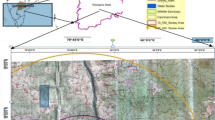Abstract
ECOMAG software complex was adapted to simulate river runoff in the Amur basin using data from global databases (relief, soils, landscapes). The results of model calibration and verification were used to give a statistical estimate of the efficiency of river runoff calculation over a long period based on standard data of meteorological and water management monitoring. The results of calculations using the developed runoff formation model were used in the space and time analysis of the formation conditions of 2013 flood in the Amur basin.
Similar content being viewed by others
References
Bolgov, M.V., Alekseevskii, N.I., Gartsman, B.I., Georgievskii, V.Yu., Dugina, I.O., Kim, V.I., Makhinov, A.N., and Shalygin, A.L., The 2013 extreme flood within the Amur basin: analysis of flood formation, assessments and recommendations, Geogr. Nat. Resour., 2015, no. 3, pp. 225–233.
Borshch, S.V., Burakov, D.A., and Simonov, Yu.A., A method for prompt calculation and prediction of daily water inflow into the Zeya HPP reservoir, Tr. GU GMTs RF, 2016, no. 359, pp. 106–127.
Bugaets, A.N., Developing methods to determine the structural-hydrographic characteristics based on DEM data for hydrological modeling, Extended Abstract of Cand. Sci. (Techn.) Dissertation, St. Petersburg: Russ. State Hydromet. Univ., 2011.
Gartsman, B.I., Dozhdevye navodneniya na rekakh yuga Dal’nego Vostoka: metody raschetov, prognozov, otsenok riska (Rain-Induced Floods in Rivers in the Southern Far East: Methods for Calculation, Prediction, and Risk Assessment), Vladivostok: Dal’nauka, 2008.
Danilov-Danil’yan, V.I., Gel’fan, A.N., Motovilov, Yu.G., and Kalugin, A.S., Disastrous flood of 2013 in the Amur basin: genesis, recurrence assessment, simulation results, Water Resour., 2014, vol. 41, no. 2, pp. 115–125.
Kalugin, A.S., Developing runoff formation model for the Amur R. based on ECOMAG information–simulation complex, in Sb. tr. Vseros. nauch. konf. “Nauchnoe obespechenie realizatsii Vodnoi strategii Rossiiskoi Federatsii na period do 2020 g.” (Proc. All-Russia Sci. Conf. “Scientific Support of the Implementation of Water Strategy of the Russian Federation for Period to 2020), Petrozavodsk: Kar. Nauch. Ts. Ross. Akad. Nauk, 2015, vol. 1, pp. 149–155.
Kryzhov, V.N. and Vil’fand, R.M., Macrometeorological formation conditions of heavy precipitation in the Amur basin in June–September 2013 and the quality of their forecasting, in Ekstremal’nye pavodki v basseine r. Amur: prichiny, prognozy, rekomendatsii (Extreme Floods in the Amur basin: The Causes, Forecasts, and Recommendations), Moscow: Rosgidromet, 2014, pp. 40–53.
Makhinov, A.N., Kim, V.I., and Voronov, B.A., 2013 flood in the Amur basin: causes and effects, Vestn. DVO RAN, 2014, no. 2, pp. 5–14.
Mnogoletnie dannye o rezhime i resursakh poverkhnostnykh vod sushi (Long-term data on the regime and resources of surface continental water), vol. 1, no. 19, Basseiny Amura (bez basseinov Shilki, Arguni, Ussuri, Amazara) i Udy (Basins of the Amur (Less the Basins of the Shilka, Argun, Ussuri, and Amazar) and Uda), Leningrad: Gidrometeoizdat, 1986.
Motovilov, Yu.G., Hydrological simulation of river basins at different spatial scales: 1. Generalization and averaging algorithms, Water Resour., 2016, vol. 43, no. 3, pp. 429–437.
Motovilov, Yu.G., Developing an information support system for on-line operation of water resources and floodcontrol measures in the Amur basin as a whole. Report of GTS Register Center, Moscow: Rosvodresursy, 2009.
Motovilov, Yu.G., Danilov-Danil’yan, V.I., Dod, E.V., and Kalugin, A.S., Assessing the flood control effect of the existing and projected reservoirs in the Middle Amur basin by physically–based hydrological models, Water Resour., 2015, vol. 42, no. 5, pp. 580–593.
Semenov, E.K., Sokolikhina, N.N., Tatarinovich, E.V., and Tudrii, K.O., Synoptic conditions of the formation of a catastrophic flood on the Amur River in 2013, Russ. Meteorol. Hydrol., 2014, no. 8, pp. 521–527.
Fal’ko, V.V., Modeling the hydrograph of summer–autumn runoff taking into account the role of forests for small watersheds in Primor’e, Extended Abstract of Cand. Sci. (Geogr.) Dissertation, Vladivostok: Pacif. Geogr. Inst., Far-East. Branch, Russ. Acad. Sci., 2002.
Frolov, A.V. and Georgievskii, V.Yu., 2013 extreme flood in the Amur basin, in Ekstremal’nye pavodki v basseine r. Amur: prichiny, prognozy, rekomendatsii (Extreme Floods in the Amur Basin: Causes, Forecasts, Recommendations), Moscow: Rosgidromet, 2014, pp. 5–39.
FAO/IIASA/ISRIC/ISS-CAS/JRC. Harmonized World Soil Database (Version 1.2), Rome: FAO, 2012; Laxenburg, Austria: IIASA, 2012.
Gelfan, A., Motovilov, Y., Krylenko, I., Moreido, V., and Zakharova, E., Testing the robustness of the physically- based ECOMAG model with respect to changing conditions, Hydrol. Sci. J., 2015, vol. 60, nos. (7–8), pp. 1266–1285.
Leij, F.J., Alves, W.J., and van Genuchten, M.Th., The UNSODA unsaturated soil hydraulic database, Proc. Int. Workshop on Characterization and Measurement of the Hydraulic Properties of Unsaturated Porous Media, Riverside, USA, 1999, p. 1602.
Loveland, T.R., Reed, B.C., Brown, J.F., Ohlen, D.O., Zhu, Z., Yang, L., and Merchant, J.W., Development of a global land cover characteristics database and IGBP DISCover from 1 km AVHRR data, Int. J. Remote Sensing, 2000, vol. 21, nos. (6–7), pp. 1303–1330.
Motovilov, Y.G. and Gelfan, A.N., Assessing runoff sensitivity to climate change in the Arctic basin: empirical and modelling approaches, IAHS Publ., 2013, vol. 360, pp. 105–112.
Motovilov, Y., Gottschalk, L., Engeland, L., and Rodhe, A., Validation of a distributed hydrological model against spatial observation, Agric. Forest Meteorol., 1999, vol. 98–99, pp. 257–277.
Moriasi, D.N., Gitau, M.W., Pai, N., and Daggupati, P., Hydrologic and water quality models: performance measures and evaluation criteria, Trans. ASABE, 2015, vol. 58, no. 6, pp. 1763–1785.
Saxton, K.E. and Rawls, W.J., Soil water characteristic estimates by texture and organic matter for hydrologic solutions, Soil Sci. Soc. Am. J., 2006, vol. 70, pp. 1569–1578.
www.esoil.ru/.
https://lta.cr.usgs.gov/HYDRO1K.
http://meteo.ru/.
Author information
Authors and Affiliations
Corresponding author
Additional information
Original Russian Text © A.S. Kalugin, Yu.G. Motovilov, 2018, published in Vodnye Resursy, 2018, Vol. 45, No. 2.
Rights and permissions
About this article
Cite this article
Kalugin, A.S., Motovilov, Y.G. Runoff Formation Model for the Amur River Basin. Water Resour 45, 149–159 (2018). https://doi.org/10.1134/S0097807818020082
Received:
Accepted:
Published:
Issue Date:
DOI: https://doi.org/10.1134/S0097807818020082




